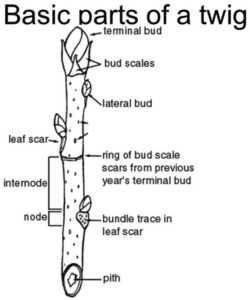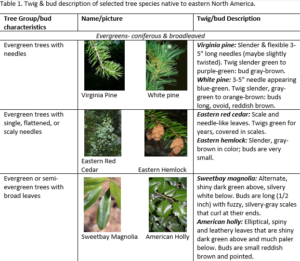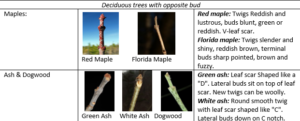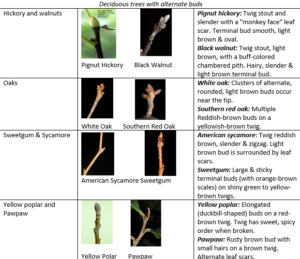Ask a Naturalist: Winter Tree Identification Skills
Woody plants known as “trees” show various anatomical strategies to survive in winter, dubbing them “winter trees.” While evergreen trees retain their waxy cuticular leaves, deciduous trees (trees that shed leaves before winter) lose their leaves to conserve little available energy and go dormant. As the evergreen trees such as pines, the eastern red cedar, and holly will retain leaves, needles and scales and are perhaps a little easier to identify, pinpointing naked deciduous trees can be extra challenging. It is important to note here that deciduous winter trees never lose their identity in winter. Instead, they show off their characteristic twig features, including the shape/color/arrangement of buds and leaf scars that add new growth to the tree come spring. In addition, a closer inspection of color/pattern/structure differences of bark, leaf litter, and seed remnants can help familiarize with winter trees. The twig anatomy picture below also comes in handy when consulting a field guide or talking to a tree expert.

Buds & Leaf Scars: The shape and color of buds and leaf scars, among others, are some of the important characteristic features visible in winter trees. Buds include growth and flower buds that add growth to the trees the following spring. Leaf scars are marks left by fallen leaves before winter. If you live in eastern North America, a rule of thumb is to check whether the tree has an opposite, alternate, or whorled bud arrangement when identifying winter trees. As the tree with whorled bud arrangement is rare in our area, focusing on trees with alternate and opposite bud arrangements covers the majority of tree species. Maple, Ash, Dogwood Horse Chestnut and Buckeye (MAD Horse’s Buck for short) trees have opposite bud arrangements. The rest of the tree species exhibit alternate bud arrangements with a wide range of shapes, colors and patterns. In addition, the shape and color of leaf scars left by fallen leaves provide an important clue in identifying winter trees.


![]()

Bark: Tree bark, on the other hand, does not exhibit any similarities among species, at least the ones we can discern. It is not an overstatement to say that there are as many bark features as there are tree species. Younger trees usually have smoother bark and develop specific features as they grow older. These features include but are not limited to: deep furrows, stripes, scales, plates, etc. American beech, American Holly, and Sweetbay Magnolia have smooth bark on both young and old trees, albeit with lenticels (lens-shaped light-colored openings on the plant for gas exchange) arranged in a different pattern. Yellow poplar, ash, and hickory show diamond-patterned bark on older trees, but all have different colors and slightly different characteristics in the shape and depth of their diamonds. Yellow poplar and ash have a whitish to off-white hue on their bark, but hickory has dark grey bark. Maple trees develop ridges and stripes when they grow older. Among the two most common maples, Florida maple has thick, irregular, curling platy ridges, while red maples have long fine platy stripes. Dogwoods have scaly bark breaking up into square blocks regardless of the tree’s age only becoming more pronounced as they age. Among the commonly found oaks in the area, white oaks have rectangular-shaped, irregular, platy white bark and red oaks develop deep or shallow furrowed bark. Southern red oak has dark, thick blocks with scaly ridges. Young trunks of the northern red oaks are dark grayish & smooth and show light and dark zebra patterns as they mature. Habitat and weather can impact the bark features described above, which may result in color and pattern variations even for the same species growing in different geographical locations.
References
Sibley, D. (2009). The Sibley guide to trees. Alfred A. Knopf ; New York.
C Frank Brockman, Merrilees, R. A., Latimer, J. P., & Karen Stray Nolting. (2002). Trees of North America : a field guide to the major native and introduced species north of Mexico. St. Martin’s Press.
Virginia Tech Dendrology Website- http://dendro.cnre.vt.edu/dendrology/syllabus/biglist_frame.cfmferences: